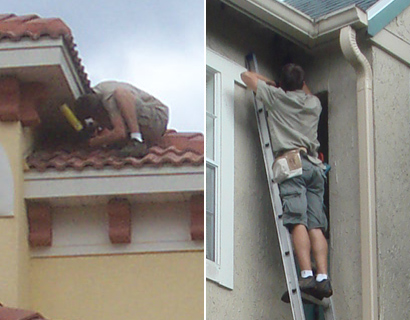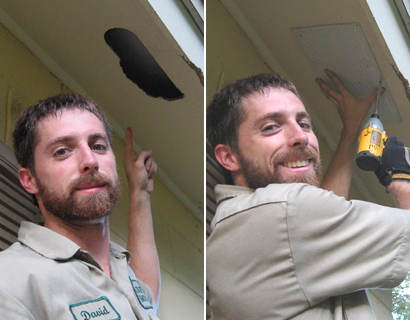- How We Solve Washington Wildlife Problems
How We Solve Seattle Wildlife Problems
INSPECTION: Once on site, we will perform a full inspection of your home and property. This allows us to use the correct strategy and traps. If the animals are in an attic, a full building inspection is crucial, including the following:
- All ground-level areas, such as piper or A/C line entry & exit areas, A/C chase bottoms, ground-level vents, etc.
- All mid-level areas, such as dryer vents, siding gaps, first floor eaves or dormers, etc.
- We inspect the entire roof, including all plumbing stacks, ridge caps, vents, and other potential gaps or holes.
- We also inspect inside your attic, to identify animals and damage they have caused.
- If the animals are outside, we notice many subtle clues that will assist us in a successful strategy.
TRAPPING, EXCLUSION, REMOVAL: Once we understand what animal species we are dealing with, and the problem, we use the most effective means of removing the animals. We use dozens of different types of traps.
- Trapping - If trapping the animal(s) in live cage traps, trap type, set, and location are crucial to success.
- Exclusion - Oftentimes, we are able to simply set one-way doors or other exclusion devices that allow the animals inside a building to safely exit, but never get back inside.
- Removal By Hand - Sometimes we actually remove animals by hand, or with special tools like snare poles.
- The Law - In all cases, we obey state and local laws regarding wildlife, but aim to take the most humane approach.
ENTRY HOLE REPAIRS: Repairs are a crucial step in the wildlife removal process. In many cases, such as bat or rodent control, the job cannot be performed without detailed repairs, and in all cases, sealing the entry holes shut ensures that no future wildlife will ever enter your home.
- 100% of the entry holes must be found, and sealed shut, or the job is not complete.
- Our repairs are professional contractor grade, look good, and when applicable we use steel, which rodents such as rats or squirrels are unable to chew through.
- We give a written guarantee on our repairs against any future animal entry.
ATTIC DECONTAMINATION SERVICES: It may be desirable to clean your attic after we've removed the animals. They can leave behind large amounts of droppings, urine, hair, oils, food, nesting material, and so on. These remnants can attract insects like cockroaches, and the scent left behind can encourage new animals to chew their way into your house. You might experience odor problems from the waste. It's possible that mold will grow on waste areas.
- We remove or vacuum all droppings, or remove all the soiled insulation.
- We fog the attic with a special enzyme-based cleaner that destroys any organic matter and deodorizes the space.
- We repair damage, such as ductwork, electrical wires, pipes, insulation, and more.
Raccoons are the number one pest for most Seattle residents. The raccoons love to feast upon the neighborhood trashcans during the night, and they may even look for nearby shelter so they can remain close to their food source. So if you find yourself with a raccoon knocking your trashcans over, or even trying to enter your home feel free to give us a call. We provide top of the line wildlife trapping, removal, and prevention. We proudly service the following cities: Algona, Arlington, Bonney Lake, Bremerton, Brier, Burien, Covington, DuPont, Edgewood, Fife, Fircrest, Gig Harbor, Issaquah, Kenmore, Lacey, Lake Forest Park, Lake Stevens, Lakewood, Lynnwood, Maple Valley, Medina, Mill Creek, Milton, Monroe, Mountlake Terrace, Mukilteo, Newcastle, Normandy Park, North Bend, Pacific, Poulsbo, Puyallup, Ruston, SeaTac, Seattle, Shoreline, Sumner, Tukwila, Tumwater, Woodinville, Woodway, Tacoma, Bellevue, Everett, Auburn, Edmonds, Marysville, Federal Way, Kent, Kirkland, Mercer Island, Redmond, Renton, Sammamish, Shoreline, Snoqualmie, Ballard, Phinney Ridge, Fremont, Wallingford, Queen Anne, and Capitol Hill. We also service the following counties: Snohomish County, Pierce County, Chelan County, Kittitas County, and Kitsap County.
Other Seattle animal pest control topics:
What Do Wildlife Rehabilitators Do with Bats?
What Equipment is Needed to Trap a Rat?
What Should I Do if I Find a Nest of Squirrels in the Attic?
What Should I Do With a Skunk After I Catch it?
To learn more about our services, visit the Seattle wildlife control home page.
This month's wildlife how-to article: How to inspect a house for pigeon entry holes
How to inspect a house for pigeon entry holes
Pigeons do have varying body sizes , however, most can crawl through entry holes measuring at least 2 inches in diameter. There are quite a number of inspection steps you must carry out in order to ascertain the level of damages caused by pigeons and how they actually gain entrance into your property.
Uncapped chimneys should be your first priority from the roof. You should inspect a chimney that has damaged cap or has no cap at all. You need to remember that the cost of removing a dead pigeon from a chimney may be higher than capping the chimney.
Inspect the attics and other crawl spaces. Once you have completed inspecting the chimney, your next inspection should be focused on crawl spaces and attics. Try as much as possible to close all holes with some balls of papers and then shut or seal each entry one at a time, once all holes have been covered with pieces of paper balls. When inspecting attics and crawl spaces, you will need to crawl through such spaces to ascertain the holes through which pigeons gain access. You may need a gas mask and a convenient overall clothing.
Inspect edges of doors and windows. While pigeons are usually not the largest of bird species, their bodies are quite small enough for them to squeeze through small openings. Door edges may be irregular and can provide some space for small pigeons to squeeze through. Similarly , window edges that are not sealed may provide sufficient spaces for pigeons to move through and gain access into the main building. All these irregular edges must be inspected before the ideal sealing or replacement options are considered.
Inspect gardens , yards, garages, patios, porch and deck. When pigeons want to roost in a property, their first point of call are external areas such as garages, yards and patios. In order to inspect holes in these places correctly, you need to evacuate every item within , because some holes are covered by some items. Make sure you inspect holes in morning or afternoon when visibilities are good enough. Broken woods, and edges around garage and yard doors are often places where most holes are created , thus you must focus most of your attention on these. Un-leveled ground surfaces may also provide access points for pigeons , especially when such irregular ground surfaces create sufficient space under the doors for pigeons to move through.





